| ALL ABOUT MATS
|
 |
| When just a picture frame simply won't cut it, sometimes a mat is precisely what's needed to take your favourite painting or photograph from pretty to perfect.
While the art of picture framing - as we think of it today - has been around since the 15th century, the concept of a division between the glass and the image, and the frame and the image, was not established until much later. Today, mats, or matboards as they're often called, are available in a mind numbing quantity of choices. Should you choose regular or conservation and in what color? What thickness should you select, how wide should the border be, and should you opt for a single, double, or triple mat?
This article discusses the different materials and attributes of picture framing mats, as well as a brief outline on matting your own images. Read on for more information!
|
| MATERIAL |
- Wood pulp for less expensive brands
- Acid-free cotton for conservation-grade
|
| TYPE |
|
| USAGE |
- Aesthetically-pleasing picture frame displays
- Protect artwork from glass condensation
- Easy mounting in frame
|
|
|
| THICKNESS |
|
| COLOR |
- A vast range of colors, from white to black
- Various textures, patterns, and prints
|
| STYLE |
- Grooved lines
- Diagonal corners
- Double or triple mats
- Painted or decorated face
|
|
| HISTORY AND MATERIALS |
 |
EARLY MATBOARDS
Before the invention of the specialty mats available today, framers who recognized the need for a spacer between the glass and the artwork used sign board.
Made from wood pulp paper, the sign board did the trick, but just didn't hold up to the longevity expected from fine art. This was due to the existence of lignin, a natural adhesive in wood. Over time, and in reaction to light and humidity fluctuations, lignin breaks down into acid that can damage artworks by causing "acid burn" discoloration and deterioration of the media and paper.
Because this process works slowly, it took around two decades for framers to realize there was a problem with their current method. When customers began to complain about discoloration and other worrisome problems with their old pieces, manufacturers knew a change was needed.
INTERIM PROTECTION
The use of cotton-based paper was recommended while a more permanent solution was explored. By using this lignin-free material - called barrier paper - to separate mat and artwork, the dangerous acids in the matboard could not harm the art. This temporary method ushered in the practice of "conservation framing."
Manufacturers began experimenting with cotton-based papers, working toward a material that combined the lasting quality of cotton and the thickness of the original matboards. What they came up with was a thick, rigid paper with a core made from recycled cotton rags. These mats were called Rag Mat boards, and this name persists today, though the components have since been altered. The colored paper affixed to the front of the mat were still made from wood-based paper, however.
MUSEUM-GRADE MATS
Museums and other institutions for whom conservation was a vital aspect were still nervous after the debacle of the early matboards. Despite assurances that Rag Mat would protect artworks from damage for 100 years or more, archivists demanded something formulated specifically for their archival framing needs, something that would never damage the art, even over hundreds of years.
At the insistence of the archivists, manufacturers began soaking the wood-based paper in calcium carbonate, which neutralized the acids. This was not good enough, though, because over time acids in the air could again make the paper acids unstable. Finally, a 100% lignin- and acid-free mat was designed: Museum Board (or Museum Rag).
MATBOARD OPTIONS
Taking what they learned, manufacturers also corrected the acid-burn issue in their regular mats, the ones for people who probably did not require more than 100 years of acid protection. Regular matboards pass through the acid-neutralizing bath which ensures the safety of the artwork for at least a century.
The result of all this fine tuning is a wide selection for consumers, which ensures they have access to the right mat for their budget and framing needs.
- Regular Matboard is made from wood pulp paper, but fully acid-neutralized.
- Rag Matboard has a cotton core and an acid-neutralized wood pulp face paper.
- Museum Rag Matboard is made entirely of cotton, with absolutely no lignin or acid.
- Black Core Matboard is a Regular mat with a black core instead of white or off-white, commonly desired with dark-color mat or very dark artworks, to avoid a white line around the art (created by the bevelled edge).
|
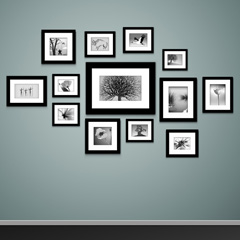 Multiple Frames with Mat
Multiple Frames with Mat
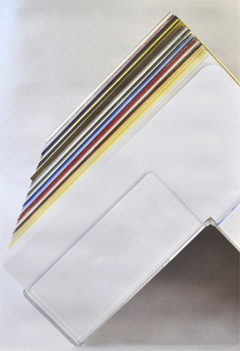 A matboard sample display
A matboard sample display
|
| IMPORTANCE OF MATS |
 |
So why use a mat?
AESTHETIC
A mat can provide a pleasing distinction between the frame and the artwork - a sort of breathing space for the eye. The viewer takes in the artwork, and their vision naturally wanders toward the corner. When it reaches the mat, it is forced to pause, and will often be drawn back to the image, rather than out past the frame and on to the next piece.
Mats can also highlight or draw out certain colors or design aspects of an artwork. Try placing a white mat on an image, and then a deep royal blue, or purple. You will most likely be shocked at the difference. Choosing the right mat is important, however, because as easily as a mat can improve the image, it can also detract from it.
CONDENSATION
Separation of the glass and the artwork is necessary because of the condensation that can build up on the inside of the glass. Condensation is caused by changes in temperature and humidity, and while these factors are closely monitored and controlled in a museum setting, environmental stability is much more difficult to ensure.
If the artwork is pressed against the glass, the moisture on the cover and transfer to the paper, causing water damage or mold growth. In the case of photographs, any moisture can cause the photo to adhere to the glass, resulting in a separation of the photographic image and the photo paper - essentially transferring the image from the paper to the glass. Furthermore, pastel and charcoal artworks can rub off on the glass, smudging or completely erasing sections of the image.
MOUNTING
Matboards are a great help in the process of mounting the artwork inside the frame. If artwork is adhered in a manner that cannot be undone without damage to the art, it is no longer archival-grade. The mat allows the edges of the artwork to be suitably hidden, as well as any adhesives used to hold the art in place. Often, the artwork is mounted with a strip of pressure-sensitive tissue to the top edge of the mat. This mounting tissue is acid-free and can be removed without damage to the art.
|
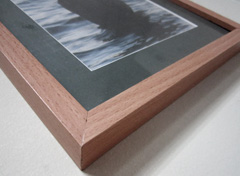
A mat adds to the display
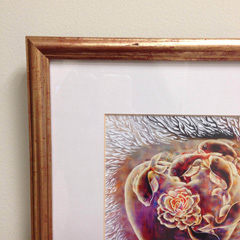
Stylish separation of art and frame
|
| MATBOARD ATTRIBUTES |
 |
THICKNESS
Mats come in different thicknesses that allow the consumer greater selection. Each mat has a designated "ply" which is not a standardized measurement (like inches). Standard mats are 4 ply, and different brands may vary by as much as 0.01 inch. 6 ply and 8ply mats are also available.
The difference in mat thickness is usually tied to the price - thicker mats are more expensive. This is because a deeper (thicker) mat is thought to give artwork a more "professional" look. Thicker mats are also sturdier, reducing the possibility of bending or warping within the frame.
COLOR AND TEXTURE
The color possibilities of matboards today is nearly endless. From countless shades of white to rich emeralds and violets, smooth, textured or even suede, there is a mat option perfectly suited to every artwork. Despite this, versions of white (Digital white, Soft white, Crystal white, Chalk, etc) remain very popular, perhaps because the selection process don't feel as daunting.
Most mats have a subtle texture (usually a fine checked pattern) created by the weave of the press used in adhering the layers of material. Completely smooth textures are available, such as fabric facing, and even prints (sports, animals, etc).
As mentioned above, the mat's core is traditionally an off-white or cream color. In addition to this and the black core, there are also white core mats that are intended to bring out the color of the artwork and retain their brightness for as long as they are displayed.
STYLE
Bevelled Edge
Traditionally, mat openings are cut on a 45° angle, which allows the bevelled lip of the core to show around the outside of the artwork. The thickness of this lip depends on the thickness of the mat. This type of slanted cut requires a special cutter designed especially for matboards.
Multiple Mats
In addition to the bevelled edge, mats can be altered or arranged in a variety of styles. One option is a display of multiple mats. A double mat generally has a top mat of about 2" (the standard, but whatever width size and preference call for), and a second mat with a "reveal" of 1/4" to 1/2" below. Double or triple (a third mat with a small reveal, below the second) mat layouts have the advantage of highlighting multiple colors within the artwork, and adding to the thickness of the mat, allowing a lower ply to be used.
Other Designs
Mats can also have shapes cut beyond the basic square or rectangle opening, or added embellishments on the face.
- A French mat serves as kind of faux double mat, achieved by etching a narrow groove (French line) in the mat face about 1/2" from the inner edge. Sometimes a second groove is place another 1/2" in, the space between the two painted in a watercolor wash for added decoration.
- More ornate carving can be done in the face, creating a thick recessed section that may be stained a different color, or cut out all together, with a different mat below showing through.
- Multiple spaces can be cut in a single mat to allow for a series of photographs, or space for an inscription or small plaque.
- The corners of the mat opening can be cut on a diagonal. Alternately, the edges of the mat may be curved into an ogee or arch shape to create a non-rectangular interior space.
- There is no limit to the design possibilities for mats. Some frame shops offer mat detailing services, and there are many tutorials on enhancing your mat at home.
LINEN LINERS
Similar to mats in shape, linen liners are thin wooden frames that serve the purpose of a mat for canvas, instead of paper artwork. A linen liner has a bevelled edge just like a mat, with a strip of linen or other fabric adhered to the face. Some linen liners have metal lips that provide additional decoration. The liner provides distinction and space between a canvas artwork and the frame. Because canvas artwork is rarely covered with glass, liners are constructed not to require this added protection.
If you require a mat for a very large, framed image, a liner may be required. While matboard is generally available only up to 40" or so, liners are sold in long strips of moulding, so they can be cut to size. If this is the case, the frame must have a rabbet deep enough to hold the frame contents including this thicker border.
|
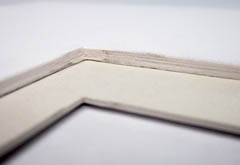
8 ply and 4 ply mat comparison
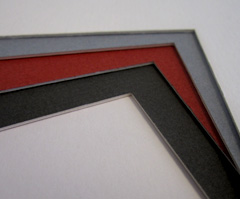
Mats come almost any color
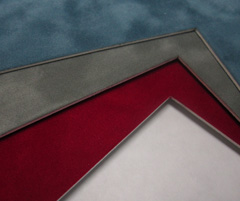
Suede matboards have a soft texture
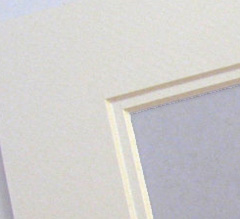
A double mat adds dimension
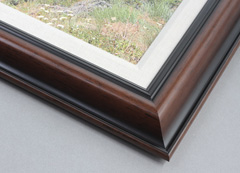
A linen liner
|
| SPECIALTY MATBOARDS |
 |
|
As mentioned briefly above, in addition to many colors, patterns and textures, mats can also be cut into shapes other than the basic rectangle or square, and multiple openings can be cut in the face of a single matboard.
Multi-photo mats offer the advantage of displaying many images without requiring a lot of frames or holes in the wall. The multiple mat openings can be arranged in a variety of ways.
Circular
Circular or oval collage mats were popular in the 1980s, and have returned to the decor scene. One of the most common uses for circular mat windows is showcasing the growth or progress of the kids. Many proud parents choose to feature a current photo in a large center opening, with each birthday or grade school photograph in the spaces surrounding it. This mat style is a way to show a child growing up without cluttering the wall with dozens of frames.
Personalized
Another fun and personal way to display photographs is with a mat with custom-cut windows in the shape of letters. The letters can spell out your family name and feature pictures from a reunion, or a child's name with pictures of them or even images they took themselves.
There are also many decorative collage mats that use square or rectangular mat windows (featured left-to-right below):
- A signature mat features a regular gallery mat opening, with a small additional opening just below the main window. This rectangular space often features an engraved plaque citing the date of the event, or a small message.
- A two-window mat can showcase two images of the same size, side by side (horizontal), or stacked (vertical).
- Three-opening mats can also be arranged vertically or horizontally, and can be used to feature a sequence of pictures from an event, photoshoot, or family vacation.
- A collage mat with four or more openings can create interesting shapes and dynamics within a single frame.
- A collage mat can also have openings of various size, which creates a playful, interesting display great for showing off newborns, vacation pictures, family faces or fine art photographs.
|
| HOW TO: MAT AND ARTWORK
|
 |
Now that the mystery of the matboard has been explained, how do you go about selecting and installing one for your own artwork?
CHOOSING COLOR AND WIDTH
First narrow down your selection by deciding whether you need a museum-grade matboard. If you plan to sell the image, graduate it to heirloom status, or if it is an original artwork, you will want to choose Conservation or Museum Rag. If you are simply framing family photos or a print of an artwork, a Regular mat will work fine.
When it comes to choosing color, make sure you have your artwork in front of you at the computer (if buying online), or bring it to the store. Consider a color that is features sparingly in your image, but seems important or particularly beautiful. If no colors seem to suit the piece, or you prefer a more traditional appearance, try the different whites and off-whites. It is amazing how differently each "white" can affect your artwork. If you already have a frame, be sure to bring this along for matching as well.
If you have a frame for your artwork, then you already know the width your mat needs to be. Otherwise, two inches is the general guideline, though don't forget it is a question of ratio, or consider slightly narrower for small artworks (8x10" or smaller) and slightly wider for large artworks (about 20x30" or bigger). Many pre-made picture frames will tell you the size of mat you require. A 20x24" frame will often say "20x24 inch image or 16x20 inch with mat."
Bear in mind if you are going with a double or triple mat, those reveals usually add on to the width of the mat (ie: 2-1/4" or 2-1/2"). Additionally, the lip of your frame will hide a bit of the mat's width (unless you specify that you want exactly two inches showing). Another measurement detail: the opening needs to be slightly smaller than the artwork so the piece does not simply fall through the mat. For more information on measuring frames and artwork, read our article on Artwork Measurements.
MOUNTING THE IMAGE IN THE FRAME
Once you have your mat, you can go to work putting together your frame. You may want to purchase some mounting tissue, but a basic domestic adhesive will work as well if you are not concerned about conservation.
Place your artwork face down on the back of the mat, and lift the two together to ensure you have it positioned correctly. Once you are satisfied, place a strip of adhesive a few inches long at the back of the mat, just above the top inside edge. By only affixing your artwork at this one point, you allow the artwork or mat to shrink or expand (a normal occurence due to humidity changes) without warping. This is called "hinging" the artwork.
Place the mat and attached artwork face down on the frame's clear cover, and place the backing on top. This "sandwich" can now be placed into the frame!
|
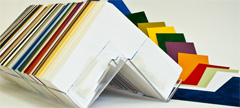
The many matboard color options
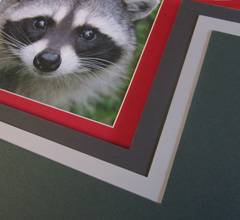
Test different mat colors
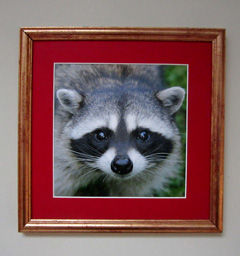
The finished piece
|
| Matboards can be a great way to spruce up simple image, or add new life to an old artwork. There are many choices to be made, but in the end the selection comes down to what you think looks good. After all, you're the one who has to look at it every day!
At KeenART Media, we are always happy to offer advice or suggestions on mat selection. If you have any questions about the process or our services, don't hesitate to contact us. Our knowledgeable staff are always happy to lend a helping hand.
NOTE: We also sell full-size, 32x40" matboards in our online store. Order Matboards now.
|
| Matboard FAQs: |
 |
Q1 : Does my artwork need a mat?
Whether or not to add a mat to your image is entirely up to you. If you intend to sell the artwork or pass it down as a family heirloom, an acid-free mat is a good idea to protect the image from the condensation that may occur on the glass. But if you are simply framing family photographs or an art print, the mat is a purely aesthetic option.
Order online:
Custom-cut matboards
Full sheet, 32x40" matboard
Q2 : What color is your whitest white?
We offer many shades of white mat board. Crystal White is our brightest white.
Order online:
Custom-size mats
Full, 32x40" matboards
Q3 : What is backing board?
Backing board is used to back or mount prints inside a frame.It is slightly thinner than a 4-ply matboard. It
Order online: Backing Boards
Q4 : Do you sell full sheets (32 x 40)?
We currently sell full matboard sheets (32x40") in certain colors.
Order online:
Full, 32x40" matboards
Q5 : What is the purpose of a mat?
Matting is the border that surrounds your art within the frame. Visually, the mat boards provide "breathing room" from any distractions on the surrounding wall including the frame. The other usage of Mat is separating the artwork from the plexi or glass.
Q6 : Should I get an acid-free mat or a regular mat?
Acid- and lignin-free mats guarantee no artwork degradation will occur because of the mat for hundreds of years. If you plan to sell your piece or show it in a gallery, a Museum core mat board is advisable. However, if you are simply framing an inexpensive piece or a print to show in your home, you should be fine with a regular mat.
Even our regular mats are treated with calcium carbonate to keep them acid-neutral for 100 years.
Q7 : How do I choose the best color mat?
A colored mat is a great way to enhance or draw out certain sections of your artwork. At the same time, a colored mat can have a detrimental effect if it does not flatter the artwork colors. Try laying different mats on top of your artwork to help you decide. If no color seems to fit, a mat in one of our many shades of white is always a good choice.
Order online:
Custom-size mats
Q8 : How much of my image will the mat cover?
The mat will cover 1/8" to 1/4" on each side of your image. This overlap is essential to ensure your artwork remains behind the mat and does not fall through. We recommend the default overlap of 1/4", but if your artwork has many important details along the edges that you do not want obscured, we can cut the mat to have an 1/8" overlap.
If your image has a white border around it, do not cut this off prior to matting. We can minimize the amount of overlap on the actual image if there is enough space around the edge.
Q9 : What is the difference between regular, conservation, and museum mat boards?
Regular mat boards are made from wood pulp, treated with an acid-neutralizer that minimizes negative reactions between the mat and artwork. They are our least expensive mat board.
Conservation mat boards have a core of acid- and lignin-free cotton, and a facing of wood pulp paper. They protect the artwork from acid burn and degradation for at least 100 years, and have a mid-range cost.
Museum core mat boards are made entirely of cotton rag paper. They are guaranteed to have no adverse reaction with artwork for hundreds of years. Museum mat boards are the most expensive and the best quality.
Q10 : Do you have more mat options than are on your website?
We do carry other options for mat boards, but they need to be ordered in, and this can delay your order. Please contact us if you require a different mat.
Q11 : How wide should my mat be?
The width of the mat is up to the customer, but we can provide some general guidelines.
For average sized artwork (about 11x14" to 30x20"), the common mat width is 2". If you artwork is smaller, you might consider a 1.75 or 1.5" mat. If you artwork is very large, a 3" or 4" mat may be necessary to ensure an aesthetically pleasing ratio.
Please see our article Measuring for Mats for more information.
Q12 : How do I order a mat board with my frame?
When you select the frame size to order, you will see an option to add "mats" to your order. When you select this, you can choose your mat color. The mat width is the thickness on one side, between the frame and the artwork (generally about 2"). If you are selecting two mats, the reveal is the amount of the bottom mat that will show between the artwork and the top mat.
Q13 : Do you carry different thicknesses of mat boards?
We can make your order with 8 ply mat boards in basic colors, however we do not keep them in stock, so ordering them may delay your order by a few days. We offer a wide selection of colors in the regular 4 ply thickness, and a double mat is a good option if you require a thicker division between plexiglass and image.
Q14 : Can I come into your store to choose a matboard?
If you are located in the Vancouver area, you are welcome to stop by our store and go through our mat samples. Unfortunately, we are an online business and do not have storefronts in other locations.
Q15 : Can I get a mat larger than 32x40 inches?
Unfortunately, our mat boards do not come in a larger size than 32 x 40, so we are unable to accommodate oversize mat orders. Have you considered having your artwork printed with a colored border?
Another option for larger artwork is to purchase a linen liner. Because these are custom made like picture frames, you can order larger sizes. Please note, however, that liners are thicker than matboards, and may require a frame with a deeper rabbet.
Order online: Full, 32x40" Matboards
Q16 : What brand are your mat boards?
Our mat boards are made by Peterboro. This Canadian company has been in the paper-making business since 1902, and their products are manufactured in and distributed from Canada.
Q17 : What is the difference between mat, matt, and matte?
Though "mat" is the most widely recognized spelling, all three words mean the same thing: a rigid paper border that divides the image from the glass and the frame.
"Matte" or "matt" may also refer to a smooth, non-reflective finish.
Q18 : How many different matboard colors do you carry?
We stock 50 regular matboard colors, as well as about 30 conservation and 18 museum core colors. However, we are able to order any color you would like. Contact us if you do not see the color you want on the website. Please remember that ordering a mat we do not have in stock will delay your order a few days.
Order online, or view our full selection in stock: Matboards
Q19 : What is the mat offset?
The offset is the amount that your mat is smaller than your image. This slight overlap ensures your artwork will not fall through your mat. However, you do not need to factor this measurement into your calculations - we will automatically cut your matboard 1/8" to 1/4" smaller on each side than your artwork size.
Q20 : What calculations do I need for ordering a mat?
All you need to know is the size of your artwork, and the width of the mat border (usually about 2" on each side). Both these amounts can be entered in our online form when you place your order.
We will do all other calculations for you, such as the mat offset and the total frame size.
Please see our article, Measuring for Mats for more information.
Q21 : What is the mat window?
The mat window, or mat opening, is the space between the two inner edges of the mat - the hole through which your artwork will show. The mat window is generally 1/4" to 1/2" smaller than your artwork vertically and horizontally. This allows for the mat offset, which overlaps your image 1/8" or 1/4" on each side, keeping the art from falling through the mat.
Q22 : Can I order Custom Cut Frame MatBoards?
Yes, to order click here: Custom Cut MatBoards
Q23 : What is the fifference between 4 ply or 8 ply matbaords?
Ply is the thickness of the matboard. The most common thickness used is 4 ply (around 1/16th of an inch) and double thick matboards are 8 ply or roughly 1/8 inch thick. The higher the number, the thicker and more rigid the board. Ply means a thickness or layer.
|
|
| If you don't find the answer you're looking for here, please contact us. |
|
© 2002-2024 - KeenART Media Ltd.
|
|
| |
|

